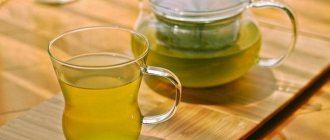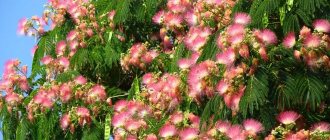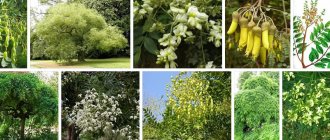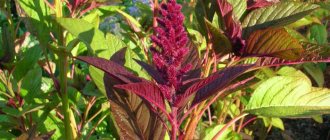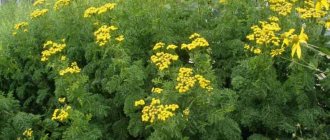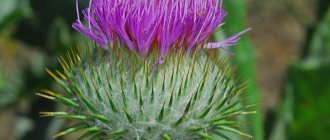Sometimes on some trees you can see unusual and very pretty decorations - other spherical plants, strewn with white berries, grow on them. Few people know that mistletoe is a parasitic shrub that can exist exclusively in this way, because it feeds on the sap of its donor. People call it everything: the witch’s nest, oak berries, holy greens, and cross grass. This plant may have different names in different regions. However, today it is known in scientific circles as mistletoe.
Witch doctors and healers have always treated this plant with special reverence. Its fruits, leaves and twigs were used in the preparation of extracts and decoctions. Healing tinctures were used to treat all kinds of illnesses and ailments. Mistletoe was used to make protective amulets. It was believed that the witch's nest protected from evil.
What does mistletoe grass look like?
This plant is a perennial shrub that remains green all year round. Thanks to the developed root system, which penetrates deeply under the donor bark, many suckers are formed. The stems, sometimes reaching 100-120 cm, have a forked-branched, segmented structure, fragile at the nodes. The woody branches of mistletoe grass form a spherical shape, which gives the plant an unusual decorative appearance.
On green or brownish-green knotted branches there are thick and veiny paired leaves up to 7 cm long. Pale green shoots usually have an oblong or elliptical shape. Old leaves, which reach one year old, begin to fall off. New sprouts and shoots soon appear in their place.
Inconspicuous small flowers appear on the tops of the stems and in the forks of the branches. They usually form a crowded bunch. Flowering occurs in early spring. At the end of August you can see ripe mistletoe berries. The fruits of the plant have a round shape with a diameter of up to 1 cm and, as they ripen, first acquire a dense and green, and then a white and transparent structure. Their flesh is sticky and slimy. The seeds of the plant are large, oval or heart-shaped.
Habitat of parasitic shrub
People who know what mistletoe is and where you can find this interesting plant say that in the wild it most often lives on poplars, lindens, willows, birches, maples, and elms. Sometimes it chooses oak trees as a donor. It prefers only pine and fir as coniferous hosts. However, it often affects garden trees: apple, pear and plum trees.
This plant is widespread in the southern part of Russia, in many regions of the North Caucasus, the Baltic regions, Belarus and Ukraine. According to biologists who study this plant and know what mistletoe looks like, in our country it is almost impossible to find it in non-black earth areas. She does not settle in the northern regions of Russia. Mistletoe is widespread in many European countries.
Harm to host trees
For most regions of Western and Central Europe, mistletoe grass is a real disaster. Once in the green area, it successfully settles on new donors, quickly capturing large areas. Well-warmed and sunlit park areas and alleys are considered favorable conditions for seed germination. In dense stands of trees with a narrow and spreading crown, mistletoe does not take root.
Affected trees become sickly and short-lived, landscape plantings lose their decorative properties. That is why in European recreation areas and places where mistletoe grows, special preventive measures are being carried out, the ultimate goal of which is to protect the plants from the parasitic grass.
Use in magical and ritual rites
Humanity has known for a long time what mistletoe is and what benefits this plant can bring to people. There are many legends about it and there are many myths. Many peoples attributed magical powers to the white berry. Protective amulets were made from branches and leaves of mistletoe. It was believed that they would protect from evil and evil spirits. In some Western European countries, people called it a “thunder broom” and burned bunches of grass in stoves to protect the house from lightning, and at the same time evil spirits. It was placed above the entrance doors so that everyone entering would leave unkind thoughts at the threshold.
In many regions, mistletoe is still associated with magic, Christmas and romance. There is still a custom of decorating their homes with wreaths made from branches of this plant. Because both the leaves and berries of mistletoe grow in pairs, the herb is believed to promote reconciliation and everlasting love. Therefore, the girl who finds herself under the branches can be kissed by each of the young people present.
Treatment with mistletoe
Mistletoe decoction
8g of dried plant, 0.5l of boiling water, simmer over low heat for 15 minutes. Decant and add volume to the original volume. Use 1 tbsp. 3 times – initial stages of hypertension, hemorrhoids, bleeding, bronchial asthma, pulmonary tuberculosis, inflammatory kidney diseases.
Sitz baths, douching, cervical erosion, leucorrhoea, for rubbing for radiculitis, sciatica, arthritis
60g of dried raw material is poured into a liter of boiling water, simmered over low heat for 15 minutes, filtered, and diluted with boiled water.
You may also be interested in: Gentian Types of gentians
Infusion
6 tsp. crushed mistletoe herb, a liter of boiling water, leave for an hour. Take a tablespoon 4 times as a tonic.
Mistletoe tincture
2 tbsp. fresh mistletoe leaf, 0.5 liters of vodka, kept for 2 weeks, filtered, squeezed. Drink 1 tsp. 3 times before meals, a month. Then they stop for a month and repeat.
Removing roundworms
Mix 5g of mistletoe leaf powder and 1g of crushed valerian root. Take 1 time at night. Eat fresh carrots at the same time. Course - 3 days.
Hypertension, improvement of heart function
- 1 tbsp. mistletoe leaves, a glass of cold water, leave for 12 hours, strain. Drink 50 ml up to 5 times;
- grind in a coffee grinder 2 tsp. mistletoe plants, brew with 2 cups of boiling water, leave in a thermos overnight, filter. Drink 2 tbsp. in small sips before meals, 20 days, break for a week. Treatment is carried out for 4 months.
Prevention of stroke and atherosclerosis
1 tbsp. crushed branches and leaves of mistletoe, a glass of water, simmer over low heat for a quarter of an hour, filter. Drink 1 tbsp. 4 times a day for 10 days, then a break of 10 days, the treatment is repeated. Several courses are conducted per year.
Bleeding in gynecological and oncological patients
Mix the powder from the leaves of the mistletoe plant with the same amount of honey. Take 2g 3 times a day.
To enhance potency
8g crushed white mistletoe, a glass of boiling water,
simmer over low heat for a quarter of an hour, leave for an hour, and strain. Drink 1 tbsp. 3 times per meal.
To reduce pressure
1 tbsp. dry mistletoe shoots, 0.5 liters of hot boiled water, incubated for 6 hours, filtered. Drink 100 ml instead of tea. Course until the condition improves.
Menopause, joint diseases, neuralgia, atherosclerosis
1 tbsp. crushed mistletoe, 400 ml of boiling water, leave for 2 hours 2 hours, drain. Drink 100 ml 4 times.
Haemorrhoids
1 tbsp. stalks and leaves of mistletoe growing on a pine tree, a glass of water, leave overnight. Drink everything in the morning on an empty stomach until complete recovery.
Bleeding in oncological and gynecological patients
Mix mistletoe powder with the same amount of honey. Take 2g three times.
Benefits for humans
In ancient times, the shoots of this plant were used to treat epilepsy, dizziness and various inflammations. It was used as a hemostatic, sedative, analgesic, laxative and diuretic. Modern scientific research in the field of studying the pharmacological characteristics of medicinal herbs used in folk medicine confirms the amazing healing properties of mistletoe. And contraindications to the use of this herb, by the way, also have scientific validity. However, more on this a little later.
Mistletoe. Use in folk medicine
A large number of people, freely using plants to treat various diseases, believe that they are absolutely harmless. However, among medicinal plants there are potent, toxic and even poisonous ones. In addition, many people, especially older people, have several chronic diseases.
Therefore, in order for the treatment to be effective, when using it, one should take into account the beneficial and medicinal properties of white mistletoe and the contraindications that the plant has, and this can only be done by a doctor. Based on this, before you start taking mistletoe medications, consult a doctor, or better yet, a herbalist you trust. The information given below is for informational purposes only.
Cardiovascular diseases
Both official and traditional medicine uses mistletoe to treat cardiovascular diseases. Plant preparations have a noticeable hypotensive effect (lower blood pressure) in hypertension of the first and second stages.
Mistletoe also helps with blood pressure in the form of pharmaceutical preparations Viskulen and Omelen. The plant is recommended for eclampsia in pregnant women. For this purpose, it is better to use mistletoe taken from willow.
In addition, plant preparations are taken in complex therapy for atherosclerosis. Mistletoe improves heart function and is used to treat certain heart diseases.
Considering the hemostatic property of the plant, its external and internal use is recommended for hemorrhoids and hemorrhoidal bleeding. Baths made from a strong decoction of mistletoe (root) have a good effect.
For inflammation and enlargement of the lymph nodes, the decoction/infusion is taken either orally or used as a lotion. Mistletoe also has indications for use for varicose veins.
For the brain
The plant is recommended for certain brain diseases. So traditional medicine, as an anticonvulsant, uses mistletoe for epilepsy and convulsive conditions.
Internal administration of plant preparations is carried out for cerebral hemorrhage (stroke). Mistletoe also helps with headaches and dizziness.
Diseases of the lungs and bronchi
Mistletoe has been used to treat the respiratory system. The hemostatic property of the plant is used for pulmonary and nasal bleeding and hemoptysis. Mistletoe helps with bronchial asthma.
For these purposes, mistletoe taken from oak or pine will have a greater effect. Also, for these pathologies, the already mentioned pharmaceutical drugs Viskulen and Omelen are prescribed.
For ear diseases, instill fresh juice 2 drops 3 times a day.
Gastrointestinal diseases
The beneficial and medicinal properties of mistletoe are widely used for diseases of the gastrointestinal tract. Plant preparations improve intestinal activity. They are prescribed for inflammation of the gastrointestinal tract, intestinal colic, and intestinal atony.
Also as a hemostatic agent, mistletoe is used for gastrointestinal bleeding, as an astringent for diarrhea and dysentery. Fresh juice is effective for rectal prolapse and poisoning from poisonous plants.
In addition, mistletoe preparations are used for worms, including round worms.
Nervous system diseases
In folk medicine, mistletoe is prescribed for diseases of the nervous system. How is mistletoe useful for these pathologies? Plant preparations have a calming effect, relieve excessive excitability and irritability, normalize sleep, which together improves the general condition of the patient and increases performance.
They are taken for neuroses, hysteria, hypochondria, and help relieve convulsions, especially those arising from nervousness.
In addition, mistletoe was prescribed for neuralgia (internal use).
Kidney diseases
In complex therapy, good results are shown in the treatment of kidney diseases with white mistletoe, mainly of an inflammatory nature, such as nephritis, etc.
For the pancreas
Mistletoe has proven its effectiveness in treating diabetes mellitus, as well as other diseases of the pancreas.
Oncological diseases
Both official and traditional medicine have recognized the benefits of mistletoe in the treatment of cancer. Plant preparations inhibit the growth of tumor cells and metastasis. Based on this, they are taken together in the postoperative period.
Also, in oncology, mistletoe is prescribed for inoperable malignant tumors.
In addition to internal treatment, external treatment is also carried out in the form of lotions. For these purposes, mistletoe growing on birch gives the best effect.
For women
Mistletoe has a wide range of effects in gynecology. The decoction is drunk during early menopause in women. It helps increase milk production in lactating women.
As a hemostatic, mistletoe is used for uterine bleeding and heavy menstruation. For the same purposes, it is permissible to take the already mentioned pharmaceutical drugs Viskulen and Omelen.
The use of mistletoe for leucorrhoea, cervical erosion, inflammation of the uterus and other diseases of the genital organs has a good effect. For this purpose, the decoction is used for douching, sitz baths, and tampons are placed.
For men
The beneficial and medicinal properties of the plant are also used for diseases of the male genital area. Mistletoe is recommended for prostatitis and enlarged prostate gland. Liquid extract helps increase potency.
For children
Mistletoe preparations are recommended for the treatment of bedwetting in children.
Skin diseases
The beneficial and medicinal properties of mistletoe have been used to treat some skin diseases, such as sciatica, psoriasis, etc. Fresh juice in the form of a lotion is applied to boils and abscesses. Also, mistletoe alcohol tincture, decoction and powder have proven to work well as an emollient and analgesic for abscesses.
Wounds, cuts
Considering the antiseptic, anti-inflammatory, hemostatic and wound-healing effects of the external infusion of white mistletoe (leaves, shoots), the juice is used in the form of washes, lotions for the treatment of wounds, ulcers, including trophic ones, and tumors from bruises. The plant helps relieve muscle pain that occurs as a result of bruises and fractures.
Joint diseases
Both internal and external use of mistletoe herb gives a good effect in the treatment of joint diseases. When taken internally, metabolic processes in the body improve, which is important for diseases such as arthritis, rheumatism, osteochondrosis, gout, etc.
Externally in the form of lotions and compresses, mistletoe preparations, including fresh juice, have an analgesic effect.
For the whole body
Mistletoe is useful for healing and strengthening the entire body. The plant has blood purifying, tonic and restorative properties. Taking mistletoe preparations gives good results in cases of loss of strength, to increase tone, as well as during the recovery period after a serious illness, nervous and physical stress, etc. Mistletoe is especially beneficial for older people.
For these purposes, preference should be given to a plant taken from a birch tree.
Panacea for all diseases
After numerous studies and scientific experiments conducted in the world's leading research centers, the healing properties of this amazing plant have been proven. Shoots, leaves and berries of mistletoe are widely used in pharmacology in the production of effective medicines for various pathologies and diseases. Today, the use of mistletoe in traditional treatment methods is becoming quite widespread in almost all areas of scientific medicine.
Based on this herb, drugs are made that are used in the treatment and prevention of cancer. Extracts and extracts from mistletoe have astringent, diuretic, hemostatic, analgesic, anti-inflammatory, anti-sclerotic and laxative properties. They help lower blood pressure, increase the activity of the heart muscles, dilate blood vessels, and reduce the excitability of the central nervous system. Today this plant is actively used in various methods of treating malignant neoplasms.
Preparations based on mistletoe are prescribed for oral administration for various forms of atherosclerosis, inflammatory processes in the kidneys, chronic inflammation of the uterus, hemorrhoids, symptoms of inflammation of the mucous membrane of the gastrointestinal tract and pancreas. They are taken for manifestations of convulsive seizures, nocturnal enuresis, tuberculosis and asthma, various neuralgia, varicose veins and trophic ulcers of the extremities. Mistletoe is widely used for uterine, pulmonary, gastrointestinal or nosebleeds.
Since ancient times, infusions and extracts from mistletoe have been used to relieve the main symptoms of rheumatism and gout. In addition, they improve the functioning of the thyroid gland and help with dizziness and weakness. For the production of pharmacological medicinal preparations, young leaves and shoots are used, both dried and fresh. Mistletoe fruits are widely used in the production of homeopathic remedies.
Instructions for use
Tincture for various internal bleeding
A glass of boiling water will require approximately 15 grams of mistletoe shoots and leaves. They are poured and placed in a warm place until they cool completely. Take orally three times a day, strictly half an hour after meals, one small spoon.
Infusion for hypertension and cancer patients
To prepare this drink, it is better to use parts of a plant grown on a birch tree. Those that have taken root on fruit trees are also suitable. Young shoots and leaves are thoroughly chopped. To prepare the drink you will need two large spoons of this paste.
Prepare the infusion in a thermos by pouring the indicated amount of the plant with one and a half glasses of boiling water. Leave for 12 hours, then filter. Use this remedy three times a day, two large spoons at a time. Drink it about a quarter of an hour before breakfast, lunch and dinner. The full course of treatment with this remedy is 4 months, but every 23 days of treatment you should take a break for exactly a week.
Solution for douching for uterine erosion
For problems with the uterus, you can use a decoction of mistletoe. To prepare it you will need 60 grams of young branches. They are poured with one liter of boiling water and placed on the stove.
After bringing to a boil, reduce the heat and let the shoots cook for about 15 minutes. And then leave it to brew for another hour. After straining, the resulting product is diluted with half a liter of warm water.
Douching will be effective if done regularly, every morning and evening.
Tincture “Male” for good potency
Mistletoe stores the most valuable substances for increasing male power in its leaves and the most tender, newly emerging shoots. It is necessary to collect 20 grams of these parts of the plant. They are mercilessly crushed and filled with a glass of 70% alcohol.
The process of converting alcohol into medicine will take place over two days in a warm, unlit place. Then the tincture must be strained and drunk three times a day, only 20 drops.
Infusion for “female” diseases
If problems arise during menstruation or menopause, you can prepare such a remedy from mistletoe. It is better to start doing it in the evening. The crushed leaves and small twigs are crushed. All you need to prepare one serving is a tablespoon of herbs. It is filled with cold water; you will need exactly 250 grams of it.
In the morning, the infusion is slightly heated and immediately filtered. Take about half an hour before meals, 100 grams at a time. The number of appointments per day depends on how serious the problems are, from two to six times.
Deworming powder
Thin young twigs and mistletoe berries are ground individually to a powder. To prepare the drug, both are taken equally. After mixing them thoroughly, separate exactly 1 gram of the resulting powder. 1 gram of valerian root powder is also added to it. This amount of medication is designed for a course of three days. Take it only once a day, and it is recommended to eat it with fresh carrots.
Compresses for the treatment of skin diseases, gout, rheumatism
Young shoots of white mistletoe are crushed. One tablespoon of the resulting mass is poured with 200 grams of boiling water, covered with a lid and left in a warm room for about an hour.
Clean gauze is folded in several layers and moistened generously in the still warm infusion. It is applied to the sore spot for a period of 20 to 50 minutes. This should be done up to three times a day.
Tea to awaken vitality
Young shoots of white mistletoe are crushed. Pour 1 small spoon of the resulting mass into a glass of boiling water. After 10-15 minutes you can drink the drink. It is not recommended to add sugar to it. To feel the effect, you need to drink at least two cups of this tea a day. But you shouldn’t be too zealous either: 4 cups is the maximum!
Mistletoe contraindications
The healing properties of this herb have been scientifically proven and confirmed by numerous studies. However, this plant also has contraindications. It has been proven that mistletoe is a poisonous plant that, if used improperly or consumed raw, can cause severe intoxication of the body. Experts do not recommend taking mistletoe infusions and extracts for people suffering from low blood pressure, as well as for pregnant and lactating women.
In addition, the use of medicinal infusions, teas and extracts from this plant for a long time is not recommended. If it is necessary to carry out several courses of treatment, breaks should be taken between them. Taking medications made from mistletoe should be carried out only after consultation and recommendations of a doctor.
The magical properties of mistletoe, dating back to ancient times
Articles on the Internet cite various legends and beliefs about the magical properties of mistletoe. It was interesting to read them. They write that she protects the house, brings lovers closer together, helps them get pregnant, and can do many other things. In Europe, Christmas wreaths are made from it and the house is decorated with them. In some countries, there is a popular tradition of kissing under mistletoe branches as a sign of long and strong love, which we sometimes see in foreign films.
All this looks romantic and shrouded in mystery, reminiscent of a beautiful fairy tale, designed to increase the confidence of already gullible buyers aimed at finding cures for oncology and weight loss.
But this is just my first impression. So think for yourself whether or not to trust the declared magical and healing properties of the popular white mistletoe.
Undoubtedly, like any natural plant, mistletoe has medicinal properties. But on the Internet it is difficult to find reliable information regarding treatment with its help. Therefore, check and double-check any advice and recommendations, look for reliable data.
This concludes my observations regarding the medicinal properties and uses of white mistletoe. In this article, I only shared my first impressions of meeting this unusual plant and, if desired, readers can continue to study this topic on their own. But, I repeat, not all sources can be trusted. Many articles are written to order and copy one another, without indicating the original source or links to official data. I would be wary of such articles.
Preparation and storage
Mistletoe grows exclusively on trees, so it cannot be cultivated. If you find a bush, you can pluck it completely, because anything is suitable for preparing healing infusions: leaves, fruits, and twigs. The plant gains the maximum amount of useful biological substances in late August - early September. This period is considered optimal for collecting grass.
To properly dry mistletoe, it is necessary to ensure good air circulation and prevent exposure to sunlight. Therefore, it is usually dried in dark and warm rooms, spread in a thin layer on paper. Some people dry mistletoe in electric dryers at a temperature of 40-45˚C. It is believed that with this method of harvesting, mistletoe does not lose its healing properties. Dried branches become pale yellow. In order to preserve all the healing properties of mistletoe for a long time, it must be stored in earthenware, limiting the access of air.
